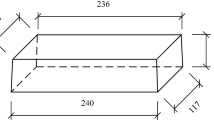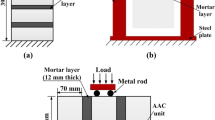Abstract
The article discusses the influence of the bed joint thickness and mortar strength on properties of calcium silicate (CS) block behavior under short-term static load. The investigation of masonry samples made of hollow CS blocks is presented in this paper. The specimens were made of two types of hollow CS blocks, combined with general purpose mortar of three different strengths and thin layer mortar of two different strengths. During the analysis of masonry with thin layer mortar the moisture influence on mechanical properties of masonry was also investigated. The experimental investigation has shown that the height of mortar bed joints has a larger influence on the mechanical properties of masonry when mortar of lower strength is used. Moistening CS blocks with thin layer mortar did not have a significant influence on the mechanical properties of masonry.











Similar content being viewed by others
References
Hilsdorf H (1969) An investigation into the failure mechanism of brick masonry loaded in uniaxial compression. Designing. In: Jonhson FB (ed) Designing, engineering and construction with masonry products. Gulf, Houston, pp 31–34
Vermeltfoort AT (2005) Brick-mortar interaction in masonry under compression. Eindhoven University of Technology, Eindhoven
Sarangapani G, Venkatarama Reddy BV, Jagadish KS (2005) Brick-mortar bond and masonry compressive strength. J Mater Civ Eng 17:229–237. https://doi.org/10.1061/(ASCE)0899-1561(2005)17:2(229)
Proske D, Gelder P (2009) Safety of historical stone arch bridges. Springer, Berlin
Berto L (2005) Failure mechanism of masonry prism loaded in axial compression: computational aspects. Mater Struct 38:249–256. https://doi.org/10.1617/14096
Kaushik HB, Rai DC, Jain SK (2007) Stress–strain characteristics of clay brick masonry under uniaxial compression. J Mater Civ Eng 19:728–739. https://doi.org/10.1061/(ASCE)0899-1561(2007)19:9(728)
Khalaf FM (1996) Factors influencing compressive strength of concrete masonry prisms. Mag Concr Res 48:95–101
Monk C (1967) A historical survey and analysis of the compressive strength of brick masonry. Research Rep. No 12. Structural clay Products Research Foundation, Geneva, Ill
Chahine GN (1989) Behaviour characteristics of face shell mortared block masonry under axial compression. McMaster University, Hamilton
Hendry AW, Sinha BP, Davies SR (2004) Design of masonry structures, 3rd edn. E & FN Spon, Edinburgh
Drysdale RG, Hamid AA (2005) Masonry structures: behavior and design, 3rd edn. The Masonry Society, Longmont
Zavalis R, Jonaitis B (2013) Experimental tests on the EC6 compressive strength of masonry made of hollow calcium silicate units. ACEE J 6:49–58
Costigan A, Pavía S, Kinnane O (2015) An experimental evaluation of prediction models for the mechanical behavior of unreinforced, lime-mortar masonry under compression. J Build Eng 4:283–294. https://doi.org/10.1016/j.jobe.2015.10.001
Bracken H, Larbi JA, Pel L, Pers N (1999) Composition of mortar as a function of distance to the brick-mortar interface: a study on the formation of cured mortar structure in masonry using. Heron 44:257–270
Ince C, Carter MA, Wilson MA, El-Turki A, Ball RJ, Allen GC, Collier NC (2009) Analysis of the abstraction of water from freshly mixed jointing mortars in masonry construction. Mater Struct 43:985–992. https://doi.org/10.1617/s11527-009-9560-5
Šlivinskas T, Jonaitis B, Drobiec Ł (2016) Assessment of bed joints behavior of calcium silicate brick masonry during execution. Eng Struct Technol 8:143–149. https://doi.org/10.3846/2029882X.2016.1238784
Baltazar LG, Henriques FMA, Cidade MT (2015) Contribution to the design of hydraulic lime-based grouts for masonry consolidation. J Civ Eng Manag 21:698–709. https://doi.org/10.3846/13923730.2014.893918
Lourenço PB (1996) Computational strategies for masonry structures. Delft University of Technology, Delft
Groot C (1995) Effects of water on mortar-brick bond. Heron 40:57–70
Huster U (2000) Tragverhalten von einschaligem Natursteinmauerwerk unter zentrischer Druckbeanspruchung: Entwicklung und Anwendung eines Finite-Elemente-. Universität Gesamthochschule Kassel (in German)
Lourenço PB, Pina-Henriques J (2006) Validation of analytical and continuum numerical methods for estimating the compressive strength of masonry. Comput Struct 84:1977–1989. https://doi.org/10.1016/j.compstruc.2006.08.009
Zavalis R, Jonaitis B, Lourenço PB (2014) Analysis of bed joint influence on masonry modulus of elasticity. In: 9th international masonry conference
Francis A, Horman C, Jerem L (1971) The effect of joint thickness and other factors on compressive strength of brickwork. In: Proceedings of 2nd international brick masonry conference. British Ceramic Research Association, pp 31–37
Drysdale RG, Hamid AA (1979) Behaviour of concrete block masonry prisms under axial compression. ACI J 76:707–722
Marčiukaitis G, Jonaitis B, Valivonis J (2004) Peculiarities of masonry deformation properties from hollow calcium silicate blocks. In: Theoretical foundations of civil engineering. Polish - Ukrainian Transactions, Warsaw, Dnepropetrovsk, pp 910–918
D’Ayala D (1998) Numerical modelling of masonry structures reinforced or repaired. In: Pande GN, Middleton J, Kralj B (eds) Computer methods in structural masonry-4: proceedings of the Fourth International Symposium on Computer Methods in Structural Masonry. Taylor & Francis, London, pp 161–168
Reddy BVV, Lal R, Rao KSN (2009) Influence of joint thickness and mortar-block elastic properties on the strength and stresses developed in soil-cement block masonry. J Mater Civ Eng 21:535–542. https://doi.org/10.1061/(ASCE)0899-1561(2009)21:10(535)
Witzany J, Čejka T, Sýkora M, Holický M (2016) Strength assessment of historic brick masonry. J Civ Eng Manag. https://doi.org/10.3846/13923730.2014.914087
Ridwan M, Yoshitake I, Nassif AY (2017) Proposal of design formulae for equivalent elasticity of masonry structures made with bricks of low modulus. Adv Civ Eng. https://doi.org/10.1155/2017/6456070
Mohamad G, Lourenço PB, Roman HR (2007) Mechanics of hollow concrete block masonry prisms under compression: review and prospects. Cem Concr Compos 29:181–192. https://doi.org/10.1016/j.cemconcomp.2006.11.003
Mohamad G, Fonseca FS, Vermeltfoort AT et al (2017) Strength, behavior, and failure mode of hollow concrete masonry constructed with mortars of different strengths. Constr Build Mater 134:489–496. https://doi.org/10.1016/j.conbuildmat.2016.12.112
Sarhat SR, Sherwood EG (2014) The prediction of compressive strength of ungrouted hollow concrete block masonry. Constr Build Mater 58:111–121. https://doi.org/10.1016/j.conbuildmat.2014.01.025
Sturm T, Ramos LF, Lourenço PB (2015) Characterization of dry-stack interlocking compressed earth blocks. Mater Struct 48:3059–3074. https://doi.org/10.1617/s11527-014-0379-3
Zhu F, Zhou Q, Wang F, Yang X (2017) Spatial variability and sensitivity analysis on the compressive strength of hollow concrete block masonry wallettes. Constr Build Mater 140:129–138. https://doi.org/10.1016/j.conbuildmat.2017.02.099
Zhou Q, Wang F, Zhu F (2016) Estimation of compressive strength of hollow concrete masonry prisms using artificial neural networks and adaptive neuro-fuzzy inference systems. Constr Build Mater 125:417–426. https://doi.org/10.1016/j.conbuildmat.2016.08.064
Jasiński R, Drobiec Ł, Piekarczyk A (2016) Mechanical properties of masonry walls made of calcium silicate materials made in Poland. Part 1. Masonry properties and compressive strength. Procedia Eng 161:904–910. https://doi.org/10.1016/j.proeng.2016.08.755
Ganzerli S, Rosslow J, Young T et al (2003) Compression strength testing for nonstandard concrete masonry units. In: 9th North American masonry conference. Clemson, South Carolina, USA, pp 60–71
Sandoval C, Roca P (2012) Study of the influence of different parameters on the buckling behaviour of masonry walls. Constr Build Mater 35:888–899. https://doi.org/10.1016/j.conbuildmat.2012.04.053
EN 772-1:2000. Methods of tests for masonry units—part 1: determination of compressive strength. CEN
EN 1015-11:1999. Methods of tests for mortar for masonry—part 11: determination of flexure and compressive strength of hardened mortar. CEN
Jonaitis B, Marčiukaitis G, Valivonis J (2009) Analysis of the shear and flexural behaviour of masonry with hollow calcium silicate blocks. Eng Struct 31:827–833. https://doi.org/10.1016/j.engstruct.2009.01.001
EN 1052-1:1999. Methods of test for masonry—part 1: determination of compressive strength. CEN
EN 1996-1-1:2005. Eurocode 6—design of masonry structures—Part 1-1: general rules for reinforced and unreinforced masonry structures. CEN
SNIP II-22-81:1989. Manual for design of plain and reinforced masonry (in Russian)
Marčiukaitis G, Jonaitis B, Valivonis J, Gnip I (2004) Assessment of deformation properties of masonry according SNIP II-22-81 and Eurocode 6. Struct Mater (Cтpoитeльныe мaтepиaлы) 11(599):48–49 (in Russian)
Khoo CL, Hendry AW (1973) A failure criterion for brickwork in axial compression. In: Proceedings of the 3rd international brick/block masonry conference. Essen, Germany, pp 139–145
Zavalis R (2013) Stress state analysis of calcium silicate hollow block masonry under compression. PhD Thesis, Vilnius Gediminas Technical University, Vilnius, Lithuania (in Lithuanian)
Author information
Authors and Affiliations
Corresponding author
Ethics declarations
Conflict of interest
The authors declare that they have no conflict of interest.
Rights and permissions
About this article
Cite this article
Zavalis, R., Jonaitis, B. & Lourenço, P.B. Experimental investigation of the bed joint influence on mechanical properties of hollow calcium silicate block masonry. Mater Struct 51, 85 (2018). https://doi.org/10.1617/s11527-018-1215-y
Received:
Accepted:
Published:
DOI: https://doi.org/10.1617/s11527-018-1215-y




